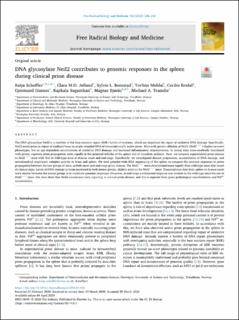| dc.contributor.author | Scheffler, Katja | |
| dc.contributor.author | Jalland, Clara Maria Osnes | |
| dc.contributor.author | Benestad, Sylvie L. | |
| dc.contributor.author | Moldal, Torfinn | |
| dc.contributor.author | Ersdal, Cecilie | |
| dc.contributor.author | Gunnes, Gjermund | |
| dc.contributor.author | Suganthan, Rajikala | |
| dc.contributor.author | Bjørås, Magnar | |
| dc.contributor.author | Tranulis, Michael A. | |
| dc.date.accessioned | 2020-09-28T08:08:59Z | |
| dc.date.available | 2020-09-28T08:08:59Z | |
| dc.date.created | 2020-04-07T13:21:15Z | |
| dc.date.issued | 2020 | |
| dc.identifier.citation | Free Radical Biology & Medicine. 2020, 152 348-354. | en_US |
| dc.identifier.issn | 0891-5849 | |
| dc.identifier.uri | https://hdl.handle.net/11250/2679861 | |
| dc.description.abstract | The DNA glycosylase Neil2 is a member of the base excision repair (BER) family of enzymes, which are important for repair of oxidative DNA damage. Specifically, Neil2 participates in repair of oxidized bases in single-stranded DNA of transcriptionally active genes. Mice with genetic ablation of Neil2 (Neil2−/−) display no overt phenotypes, but an age-dependent accumulation of oxidative DNA damage and increased inflammatory responsiveness. In young mice intra-cerebrally inoculated with prions, vigorous prion propagation starts rapidly in the germinal follicles of the spleen due to inoculum spillover. Here, we compare experimental prion disease in Neil2−/− mice with that in wild-type mice at disease onset and end-stage. Specifically, we investigated disease progression, accumulation of DNA damage, and mitochondrial respiratory complex activity in brain and spleen. We used genome-wide RNA sequencing of the spleen to compare the immune responses to prion propagation between the two groups of mice, at both onset and end-stage prion disease. The Neil2−/− mice deteriorated more rapidly than wild-type mice after onset of clinical signs. Levels of DNA damage in brain increased in both mouse groups, slightly more in the Neil2−/− mice. Transcriptome data from spleen at disease onset were similar between the mouse groups with moderate genomic responses. However, at end-stage a substantial response was evident in the wild-type mice but not in Neil2−/− mice. Our data show that Neil2 counteracts toxic signaling in clinical prion disease, and this is separate from gross pathological manifestations and PrPSc accumulation. | en_US |
| dc.language.iso | eng | en_US |
| dc.publisher | Elsevier | en_US |
| dc.rights | Navngivelse 4.0 Internasjonal | * |
| dc.rights.uri | http://creativecommons.org/licenses/by/4.0/deed.no | * |
| dc.title | DNA glycosylase Neil2 contributes to genomic responses in the spleen during clinical prion disease | en_US |
| dc.type | Peer reviewed | en_US |
| dc.type | Journal article | en_US |
| dc.description.version | publishedVersion | en_US |
| dc.source.pagenumber | 348-354 | en_US |
| dc.source.volume | 152 | en_US |
| dc.source.journal | Free Radical Biology & Medicine | en_US |
| dc.identifier.doi | https://doi.org/10.1016/j.freeradbiomed.2020.03.030 | |
| dc.identifier.cristin | 1805562 | |
| dc.description.localcode | This is an open access article distributed under the terms of the Creative Commons CC-BY license, which permits unrestricted use, distribution, and reproduction in any medium, provided the original work is properly cited. | en_US |
| cristin.ispublished | true | |
| cristin.fulltext | original | |
| cristin.qualitycode | 1 | |

